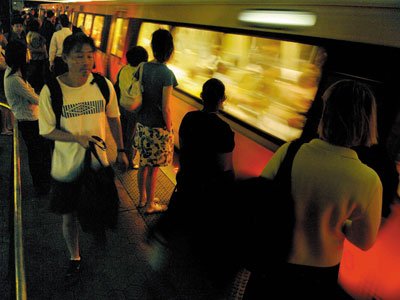To the six leather-clad Harley riders from Montreal who pulled
off the interstate to eat lunch on Wednesday, the open road seems
even more open this year.
To the six leather-clad Harley riders from Montreal who pulled off the interstate to eat lunch on Wednesday, the open road seems even more open this year.
The dining area was more than half empty, and so were many of the highways on their 1,800-mile trek to and from a motorcycle rally in Sturgis, S.D., this year’s destination on their annual visit to the U.S.
“There was much less traffic, much less congestion,” said Nathalie Miousse, 36. “This was our first time to Sturgis, and they told us it was less crowded than in other years.”
Higher prices for gas and other necessities are forcing more Americans to downshift on their summer road trips, and everyone from gas station owners to restaurant servers is feeling the pinch.
Americans drove 12.2 billion fewer miles in June compared to a year ago, the government said Wednesday, a reduction of 4.7 percent to 250.2 billion, the lowest for June since 2002 and the biggest monthly drop this year.
Driving on rural interstates fell nearly 7 percent, which is “a pretty good indication that multi-state commercial traffic and regional vacation travel are down,” said Doug Hecox, a spokesman for the Federal Highway Administration.
Highway officials expected metropolitan areas to show the biggest decline because people have mass transit as an option, but it came in rural areas instead.
“There may be broader economic reasons,” Hecox said, including high food prices and a tough job market. “The effects of that may be digging deeper in rural areas,” he said. “People in the middle of the country may just be staying home.”
Rockford, Ill.-based Road Ranger USA, operator of 73 service stations in seven Midwestern states, most in rural towns and near interstates, has seen gas sales fall 5 percent this year along interstates and urban areas and 15 percent in rural areas such as Freeport, Ill., said Dan Arnold, the company’s president.
“We’re in the eye of the storm,” Arnold said. “Summer travel is down a little bit, but in smaller communities it’s down more significantly. They have less disposable income, so higher gas prices affect them disproportionately. It just comes down to having less money to spend, so you stay home”
Gas prices aren’t the only deterrent, Lisa Schweitzer, a transportation policy expert at the University of Southern California, said.
“Not only is it expensive to get anywhere, but you have to pay more for whatever you do when you get there,” she said.
With fewer families traveling, CBRL Group Inc., owner of Cracker Barrel restaurants and gift shops commonly found along highways, saw comparable restaurant sales fall 1 percent in July and 1.2 percent in June despite increasing average menu prices 3.7 percent.
“Consumer sentiment and the drop in discretionary spending are affecting us like they are affecting everyone,” spokeswoman Julie Davis said.
At Road Ranger, Arnold knows customers are grumbling over high pump prices, so he tries to soothe them with offers like a loyalty card that gives five cents back per gallon and 25 cents off the price of one gallon if someone buys a cup of coffee.
Even with recent price declines, drivers are still searching for low prices.
His Rockford station was charging $3.859 for regular Wednesday, and he was afraid to raise it a penny more because cost-conscious consumers will quickly find lower prices. His experience is that sales will fall 30 percent at a station if he’s one cent over competitors and 50 percent if he’s three cents over.
“The consumer is hypersensitive about price shopping because that’s the only way he can exercise control,” Arnold said.
June was the eighth straight month of decline in driving, and 2008 is on pace to be the first year of decline since 1980. Americans also used 400 million fewer gallons of gas in the first quarter, according to the highway administration.
Driving miles are expected to decline again when July numbers come out because that’s when gas prices peaked at more than $4 nationally. But highway officials expect motorists will get back behind the wheel eventually and the miles to start climbing again.
“That trend will resume. We just don’t know when,” said Hecox, but he predicted the trend of using less gas will continue because Americans will buy more efficient vehicles such as hybrids and electric vehicles.
With drivers burning less gas, that will further reduce revenue from gasoline taxes, the main source of funding for highway construction and maintenance. Federal officials warn the Highway Trust Fund could go from an $8 billion balance at the beginning of the current fiscal year to a deficit of $3.1 billion in the next fiscal year, which starts in October.
Though driving is down in rural areas, it hasn’t dropped as much around big cities like Chicago.
Revenue on the Illinois Tollway system was up nearly 3 percent through June to $285 million, and the number of transactions for passenger cars and commercial vehicles rose slightly in the first half, but spokeswoman Joelle McGinnis said part of that was because 12.5 miles of new road was added, and 80 percent of traffic is local commuters.
“A majority of our system is in the metro area, and most of our travel is from commuters, so the traffic level is very stable,” she said.
As car owners think twice about getting behind the wheel, more drivers are taking trains. Amtrak ridership rose 14 percent in July to nearly 2.8 million. Ridership is up 11 percent for the year and on track to break last year’s record of 25.8 million.
Brett Sweeney and Dean Buckner, colleagues at a box manufacturer, were carpooling back to Minneapolis after traveling separately to Chicago for business. Sweeney, 42, who travels five or six times a year to Chicago, took the train here for the first time, saying he saved more than 50 percent over the cost of driving by his estimate.
“If I could have gotten a bus ticket, that was even cheaper, but the buses were all full,” he said.















